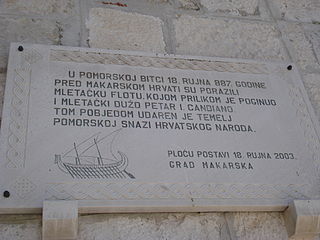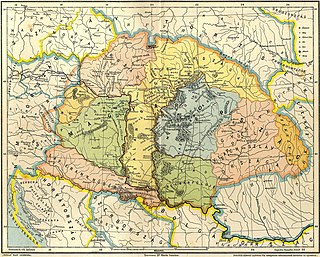 W
WThe Battle of Drava River was fought between the army of Tomislav of Croatia and the forces of Hungarian tribes led by Grand Prince Zoltán, the youngest son of Árpád, founder of the Árpád dynasty.
 W
WThe Church of the Holy Salvation or Holy Saviour was a Pre-Romanesque church in the Dalmatian Hinterland, Croatia, whose ruins are now a historic site. It is located in the small village of Cetina, near the spring of the river Cetina, 8 km northwest from the town of Vrlika.
 W
WThe Kingdom of Croatia, or Croatian Kingdom, was a medieval kingdom in Central Europe comprising most of what is today Croatia, as well as most of the modern-day Bosnia and Herzegovina. The Croatian Kingdom was ruled for part of its existence by ethnic dynasties, and the Kingdom existed as a sovereign state for nearly two centuries. Its existence was characterized by various conflicts and periods of peace or alliance with the Bulgarians, Byzantines, Hungarians, and competition with Venice for control over the eastern Adriatic coast. The goal of promoting the Croatian language in the religious service was initially introduced by the 10th century bishop Gregory of Nin, which resulted in a conflict with the Pope, later to be put down by him. In the second half of the 11th century Croatia managed to secure most coastal cities of Dalmatia with the collapse of Byzantine control over them. During this time the kingdom reached its peak under the rule of kings Peter Krešimir IV (1058–1074) and Demetrius Zvonimir (1075–1089).
 W
WThe Croatian–Venetian wars were a series of periodical, punctuated medieval conflicts and naval campaigns waged for control of the northeastern coast of the Adriatic Sea between the City-state of Venice and the Principality of Croatia, at times allied with neighbouring territories – the Principality of the Narentines and Zahumlje in the south and Istrian peninsula in the north. First struggles occurred at the very beginning of the existence of two conflict parties, they intensified in the 9th century, lessened during the 10th century, but intensified again since the beginning of the 11th century.
 W
WThe Duchy of Pannonian Croatia is a name used in Croatian historiography for a medieval Slavic duchy from the 7th to the 10th century located in the Pannonian Plain approximately between the rivers Drava and Sava in today's Croatia. At times, the duchy extended considerably to the south of the Sava, encompassing most of its basin. The modern regions it encompassed include Slavonia, Moslavina, Banovina, Bilogora and Podravina. Its political center was in Sisak.
 W
WThe Gospel of Cividale, at first named the Codex of Aquileia, is a medieval Latin transcript of the Gospel of Mark, written on parchment. It is named after Cividale del Friuli, a town in Friuli-Venezia Giulia where it is kept. It contains about 1500 Slavic and German names of pilgrims to the monastery of San Giovanni di Duino, written in the second half of the 9th and the first half of the 10th century. The monastery was a property of the Patriarchate of Aquileia.
 W
WThe Guduscani or Guduscans were a tribe around present day Gacka (Lika), between upper Kupa river and the Dalmatian coast, or the inhabitants around the river Guduča near Zadar, a Croatian tribe, i.e. the people of the Bribir region. It has been assumed, that they were part of the Vandals, Goths or Croats. However, the view that the Guduscans were Goths is not widely accepted, their state was in Italy and it ceased to exist in the 6th century, while their presence in the former Roman province of Dalmatia was not dominant. The German historian Josef Baptist von Weiß (1820–1899) thought that the Guduscani were descendants of the East Germanic Vandals.
 W
WThe Croatian interlace or Croatian wattle, known as the pleter or troplet in Croatian, is a type of interlace, most characteristic for its three-ribbon pattern. It is one of the most often used patterns of pre-romanesque Croatian art. It is found on and within churches as well as monasteries built in early medieval Kingdom of Croatia between the 9th and beginning of the 12th century. The ornamental strings were sometimes grouped together with animal and herbal figures.
 W
WThe Siege of Lastovo in 1000 was part of the campaign of Doge Pietro II Orseolo in southern Croatia and its bloodiest armed conflict between the citizens of Lastovo island and the army of Venice. The siege resulted in a Venetian victory and Lastovo was annexed into the Venetian republic.
 W
WMichael of Zahumlje, also known as Michael Višević or rarely as Michael Vuševukčić, was a semi-independent, or independent Slavic ruler of Zahumlje, in present-day central Herzegovina and southern Croatia, who flourished in the early part of the 10th century. Prince Michael of Zahumlje having a common boundary with the Serbia and probably with Kingdom of Croatia, but was an ally of Bulgaria. He was nevertheless able to maintain independent rule throughout at least a good part of his reign.